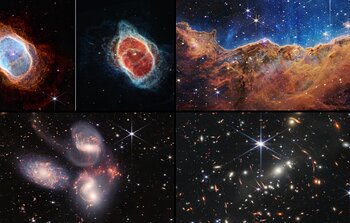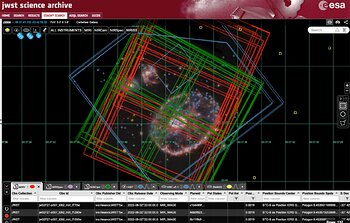From the desk of the HST and JWST Project Scientist
-By Chris Evans-
The past few months have been truly exceptional. Following the successful commissioning of each of the 17 modes of Webb’s science instruments, on 12 July the first science images and spectra were unveiled during a live NASA/ESA/CSA broadcast. The spectacular images drew a global audience across all media platforms, and the capabilities of this fantastic observatory have continued to amaze and inspire us with the further releases of the Cartwheel and Phantom Galaxies, the Tarantula Nebula, and Jupiter, Mars and Neptune. As part of the first science release, we coordinated over 40 public events across the member states to share in the celebration and wonder of this landmark achievement. Learn more about the impact and activities of the first Webb image releases and what is still to come here.
In the same week as the first Webb images release, we held the Science with the Hubble and James Webb Space Telescopes conference in Stockholm. Run in a hybrid format with in-person and remote participants, the conference provided an excellent chance to reflect on the latest Hubble results, together with the excitement of the first Webb images and data and stimulating discussions of how to best harness the unique capabilities of both missions in the coming years. Looking ahead, I am delighted to announce a conference on the First Science Results from JWST in December, which you can learn about here.
Given the excellent progress of the Early Release Science programmes, the volume of Webb data is quickly growing within the eJWST, the European mirror archive hosted at ESAC (learn more here). If these new data have already sparked ideas for future observations, you won’t have to wait long as the call for Cycle 2 General Observer programmes will be released on 15 November, with the deadline for proposals on 27 January 2023. Let me also encourage you to have a look at the latest version of ESASky which, as part of an exciting collaboration between ESA/Webb and ESASky, now includes the already iconic first images for easy exploring of their locations (full details here), as well as its user-friendly tools and catalogues to help design your next observing programmes.
The Hubble Cycle 30 TAC process concluded in June, following the review of over 1000 proposals in April and May. The successful programmes feature the largest ever fraction of time awarded to proposals led by PIs in the ESA member states (29% of the accepted proposals, and 38% of the total time). Congratulations to the successful teams, and sincere thanks to all of you who provided your time and expertise to the external reviews and review panels.
Lastly, as we look forward to science operations with these remarkable observatories, I’d like to remind you of the Space Telescope Users Committee and the JWST Users Committee. The committees are there to provide advice from you, the users, on operations of the observatories, so if you have suggestions or questions you would like to raise, please contact one of our European representatives.
Contact
Chris Evans
ESA/HST & ESA/JWST Project Scientist
ESA Office, STScI Baltimore, USA
Email: hubblenewseurope@stsci.edu

|
6 October 2022: -By Bethany Downer -
In July the dawn of a new era in astronomy began as the world got its first look at the full capabilities of the NASA/ESA/CSA James Webb Space Telescope. The telescope’s first full-colour images and spectroscopic data, which uncovered a spectacular collection of cosmic features that have remained elusive until now, were released. This began with …
|
| Read more |

|
6 October 2022: -By Bethany Downer and Deborah Baines-
We are so pleased to announce that the ESA/Webb and ESA/Sky teams have collaborated again to incorporate the spectacular Webb images featured on the ESA/Webb website into the ESA/Sky application (as is already done for ESA/Hubble images).
ESA/Sky is a web-based app that helps users to interact with outreach astronomical images and datasets …
|
| Read more |

|
6 October 2022: -By Chris Evans-
Alongside the excitement of the first Webb data, the team at ESAC’s Science Data Centre released the European JWST (eJWST) archive. This provides a fast and user-friendly European interface to Webb data, including quick-look search tools by target or proposal ID, and a powerful visual means to search the archive using ESASky search (see image …
|
| Read more |

|
6 October 2022: -By Chris Evans-
Following the successful commissioning of the NASA/ESA/CSA James Webb Space Telescope, and its move into science operations, we are already witnessing the first science breakthroughs enabled by its unprecedented infrared sensitivity and observing capabilities. To share some of these new discoveries, we are pleased to announce a conference on the First Science Results from JWST at the …
|
| Read more |